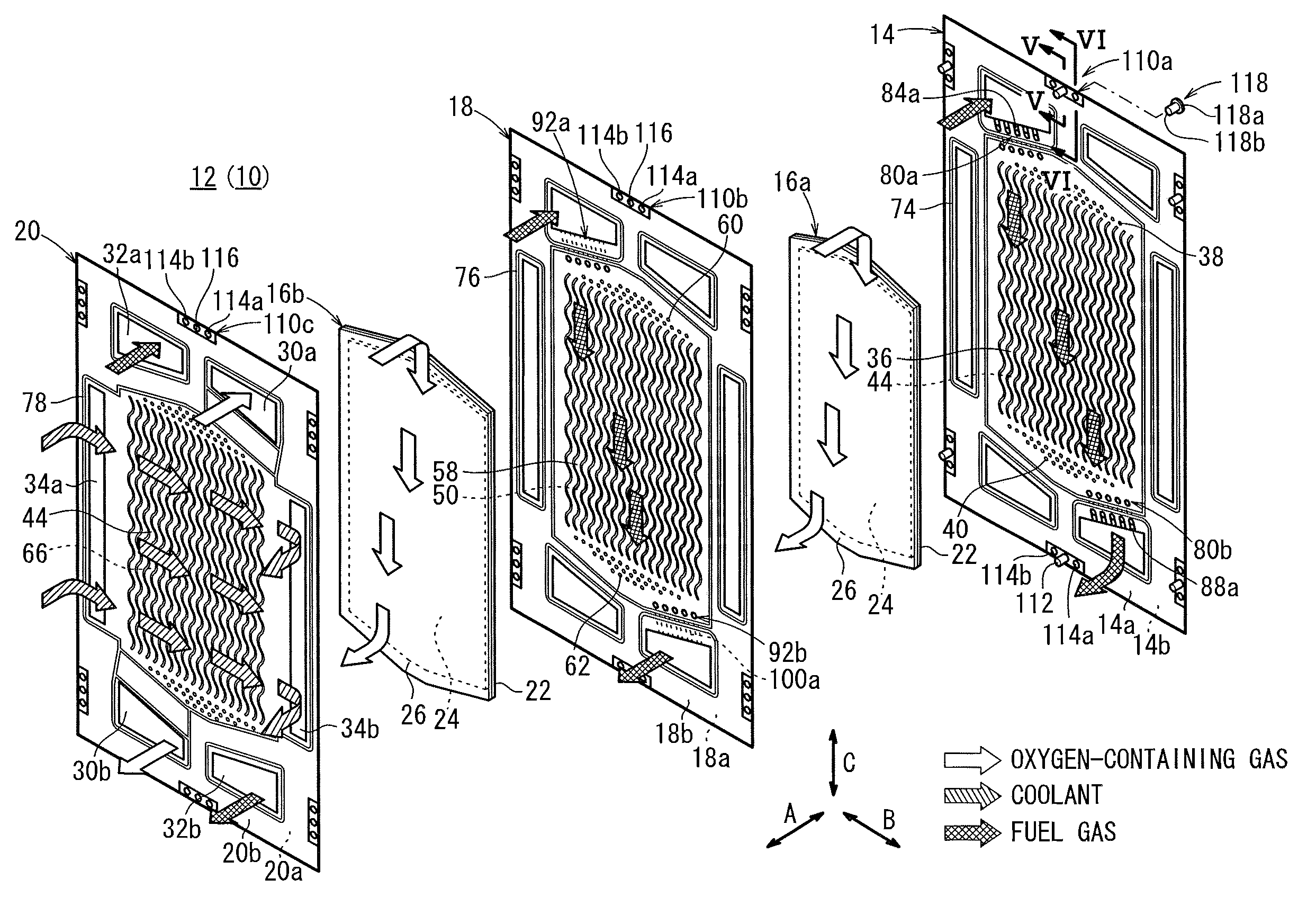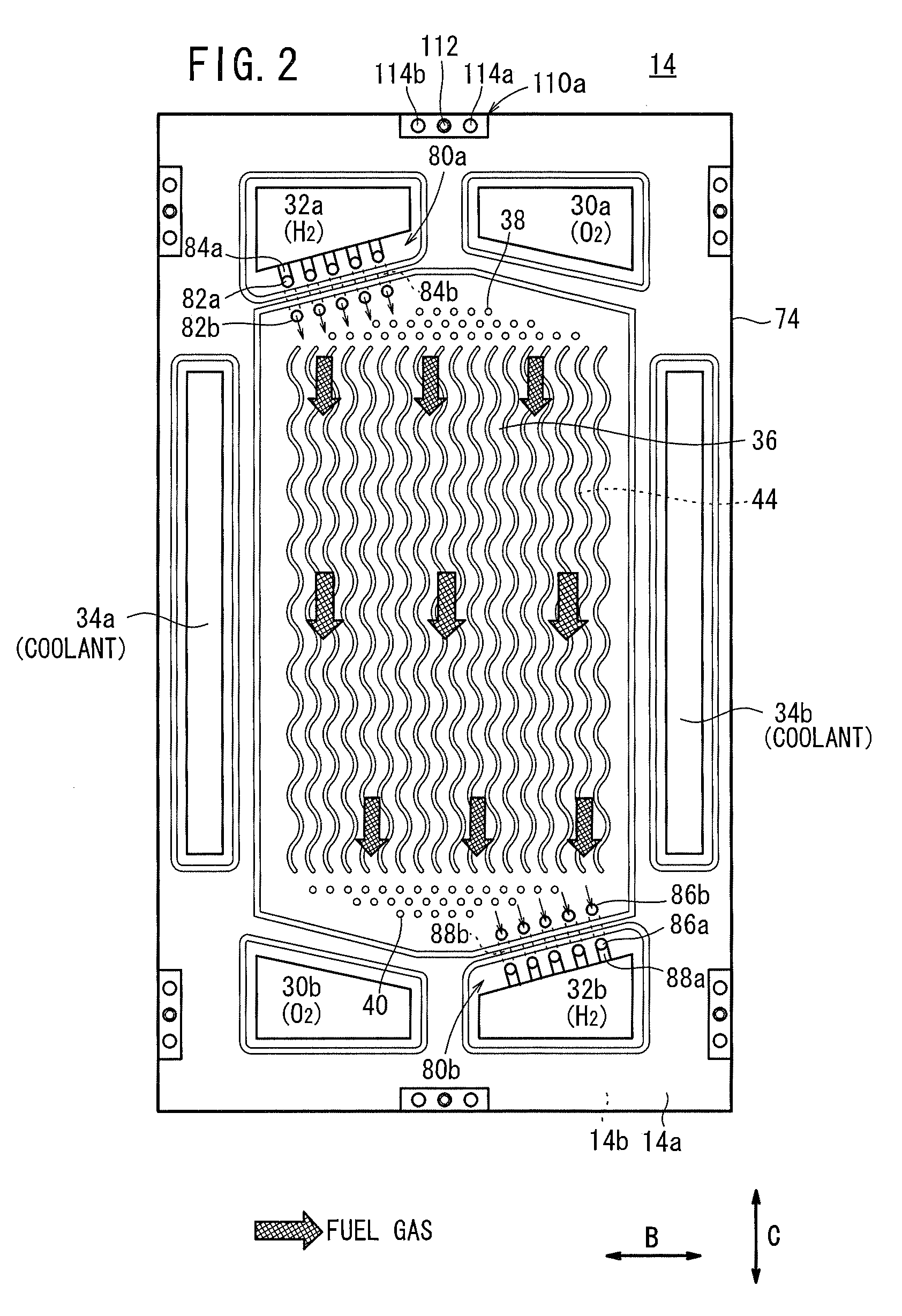Fuel cell
a fuel cell and metal clip technology, applied in the field of fuel cells, can solve the problems of inefficiency of assembling operation, laborious operation of attaching metal clip members, and inability to efficiently carry so as to achieve the effect of efficiently carrying out assembling operation of fuel cells
- Summary
- Abstract
- Description
- Claims
- Application Information
AI Technical Summary
Benefits of technology
Problems solved by technology
Method used
Image
Examples
first embodiment
[0044]As shown in FIG. 1, the fuel cell 10 according to the present invention is formed by stacking a plurality of cell units 12 in a horizontal direction indicated by an arrow A or in a gravity direction indicated by an arrow C. Each of the cell units 12 includes a first separator 14, a first membrane electrode assembly (electrolyte electrode assembly) (MEA) 16a, a second separator 18, a second membrane electrode assembly 16b, and a third separator 20.
[0045]For example, the first separator 14, the second separator 18, and the third separator 20 are metal separators of steel plates, stainless steel plates, aluminum plates, plated steel sheets, or metal plates having anti-corrosive surfaces by surface treatment. Each of the first separator 14, the second separator 18, and the third separator 20 is formed by corrugating a metal thin plate under pressure, and has a corrugated shape in cross section. Instead of using the metal separators, carbon separators may be used as the first separ...
second embodiment
[0101]FIG. 8 is a cross sectional view showing main components of a cell unit 132 of a fuel cell 130 according to the present invention.
[0102]The constituent elements that are identical to those of the fuel cell 10 according to the first embodiment are labeled with the same reference numerals, and description thereof will be omitted. Likewise, in third and other embodiments described later, the constituent elements that are identical to those of the fuel cell 10 according to the first embodiment are labeled with the same reference numerals, and description thereof will be omitted.
[0103]A cell unit 132 includes the first separator 14, the second separator 18, and the third separator 20, and resin connecting sections 134a, 134b, and 134c are provided in the outer circumferential ends of the first separator 14, the second separator 18, and the third separator 20, respectively. A coupling pin 136 projecting in the stacking direction is molded integrally with each resin connecting sectio...
third embodiment
[0106]FIG. 9 is an exploded perspective view showing main components of a fuel cell 140 according to the present invention.
[0107]The fuel cell 140 is formed by stacking a plurality of cell units 142. Each of the cell units 142 includes a first separator 144, a membrane electrode assembly 146, and a second separator 148.
[0108]At an upper end of the cell unit 142 in a longitudinal direction indicated by an arrow C, an oxygen-containing gas supply passage 30a, a fuel gas supply passage 32a, and a coolant supply passage 34a are formed. At a lower end of the cell unit 142 in the longitudinal direction, an oxygen-containing gas discharge passage 30b, a fuel gas discharge passage 32b, and a coolant discharge passage 34b are formed.
[0109]The first separator 144 has a fuel gas flow field 36A on its surface 14a facing the membrane electrode assembly 146, and the second separator 148 has an oxygen-containing gas flow field 50A on its surface 20a facing the membrane electrode assembly 146. A co...
PUM
| Property | Measurement | Unit |
|---|---|---|
| temperature | aaaaa | aaaaa |
| diameter | aaaaa | aaaaa |
| circumferences | aaaaa | aaaaa |
Abstract
Description
Claims
Application Information
 Login to View More
Login to View More - R&D
- Intellectual Property
- Life Sciences
- Materials
- Tech Scout
- Unparalleled Data Quality
- Higher Quality Content
- 60% Fewer Hallucinations
Browse by: Latest US Patents, China's latest patents, Technical Efficacy Thesaurus, Application Domain, Technology Topic, Popular Technical Reports.
© 2025 PatSnap. All rights reserved.Legal|Privacy policy|Modern Slavery Act Transparency Statement|Sitemap|About US| Contact US: help@patsnap.com



